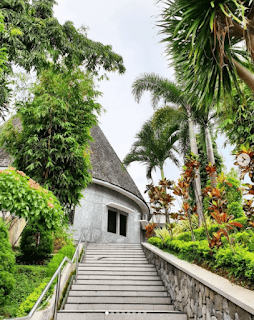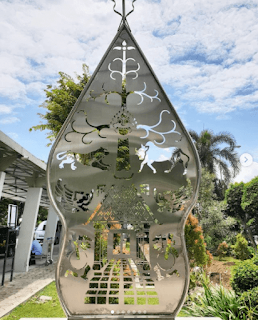Welcome to day-3 of #rsolotravelog
Day 3, in the morning, we went to Solo's Car Free Day. It was fun! Seeing how the people enjoying Sunday morning with their loved ones. The weather was pretty good too!
To reach this street, we ought to pass the alun-alun kidul first, and passing some of the buildings of Keraton Solo.
One of the interesting thing for me was the wall that surrounding the keraton. Saya copas dari wiki aja ya, males nerjemahinnya.
Kompleks keraton ini dikelilingi dengan baluwarti, sebuah dinding pertahanan dengan tinggi sekitar tiga sampai lima meter dan tebal sekitar satu meter tanpa anjungan. Dinding ini melingkungi sebuah daerah dengan bentuk persegi panjang. Daerah itu berukuran lebar sekitar lima ratus meter dan panjang sekitar tujuh ratus meter.
Patung Slamet Riyadi ini memang salah satu icon kota Solo dan berada di lokasi yang sangat strategis. Nah, berhubung penasaran siapa sih beliau ini. Mari kita simak hasil copas saya :p.
Bernama lengkap Ignatius Slamet Riyadi, Riyadi lahir di Surakarta dari pasangan Idris Prawiropralebdo dan Soetati yang tinggal di Kampung Danukusuman, Surakarta, Jawa Tengah.
Sang ayah merupakan seorang abdi dalem prajurit Kraton Kasunanan Surakarta dan ibunya seorang pedagang buah-buahan di pasar.
Ketika kecil Riyadi bernama Soekamto, hingga tak berselang lama dirinya mengalami kecelakaan yaitu jatuh dari gendongan ibunya.
Pasca kejadian tersebut Soekamto sering mengalami berbagai macam penyakit.
Menurut adat istiadat Jawa, Soekamto kecil harus disembuhkan dengan cara 'dibeli', maka dibelilah dia oleh pamannya dan namanya diganti menjadi Slamet Riyadi, supaya menyelamatkannya hingga kelak dewasa.
Riyadi meninggal di usia belia, 23 tahun.
Source: https://solo.tribunnews.com/amp/2020/03/29/sejarah-patung-slamet-riyadi-solo-ternyata-ini-kisah-di-balik-pose-sang-brigjen-acungkan-pistol?page=4
Actually really interested to explore this place, but it was closed due to a private event.
Fort Vastenburg (Dutch "Fort Steadfast"), also Fort Surakarta, is an 18th-century Dutch fort located in Gladak, Surakarta, Indonesia.
Fort Vastenburg is a square shaped fort with four bastions. It is surrounded by 6 meter high bearing wall and dry moat. Three portals providing entrance to the fort from the east, west, and north. A draw bridge used to provide access point to the fort's western main portal, however this has been demolished.
Most agreed that Fort Vastenburg was constructed in 1743 and was completed in 1745, following the order of Governor-General Baron van Imhoff. First named de Grootmoedigheid ("magnanimity"), later the fort name was renamed to Vastenburg ("steadfast") (1750).
The main function of the fort was to house the resident (colonial administrator) and the Dutch East Indies garrison for the region of Central Java. The fort maintained order in Surakarta, especially between the royalties.
Memasuki area Keraton Surakarta dari arah utara, kami melalui Gapura Gladag. Kesan yang saya dapatkan adalah sesungguhnya "gerbang" sesungguhnya bukanlah gerbang buatan manusia yang berwarna putih gading tersebut, tetapi lebih ke pohon beringin sangat rimbun yang ada di dekatnya. It gives you chills and different atmosphere. Kebetulan saja saat itu memang sedang ramai dan di pusat kota. Kalau sepi, hmm.
Eh, tumben pake bahasa Indo? Iya, soalnya saya mau copas keterangan dari wiki, dan ga nemu yang bahasa Indonesianya. Atau terlalu malas untuk mencarinya.
Gladag yang sekarang dikenal dengan Perempatan Gladag di Jalan Slamet Riyadi Solo. Pada zaman dahulu, space area di sekitar Gladag dan gapura kedua dipakai sebagai tempat menyimpan binatang hasil buruan sebelum digladag (dipaksa) dan disembelih di tempat penyembelihan. Wujud arsitektur pada kawasan Gladag ini mengandung arti simbolis ajaran langkah pertama dalam usaha seseorang untuk mencapai tujuan ke arah Manunggaling Kawula Gusti (Bersatunya Rakyat dengan Raja).
Shakespeare, Copernicus, Galileli, Da Vinci. Nama-nama tersebut hidup di abad 16, saat di mana Sultan Agung memerintah Kerajaan Mataram, yang menjadi cikal bakal Keraton Solo dan Yogya.
Jadi, terkadang saya saat melihat bangunan-bangunan ini secara langsung, juga mencoba membayangkan bagaimana situasi dan suasana 500 tahun lalu.
Bangunan di slide 1 adalah Sasana Sumewa yang merupakan bangunan utama terdepan di Keraton Surakarta. Tempat ini pada zamannya digunakan sebagai tempat untuk menghadap para punggawa (pejabat menengah ke atas) dalam upacara resmi kerajaan.
Di kompleks ini terdapat sejumlah meriam diantaranya diberi nama Kyai Pancawura atau Kyai Sapu Jagad. Meriam berbahan perunggu ini dibuat pada masa pemerintahan Sultan Agung.
Berhubung ke sininya pas lagi lari pagi, jadinya memamg mengunjungi objek yang ada secara mandiri, bisa atur pace tapi jadi ga banyak dapet info.
Sebenernya secara sejarah dan arsitektur sanhat menarik, tapi kurang terawat sayangnya.
Saya suka dengan kombinasi warna putih dan biru yang mendominasi bangunan Keraton Surakarta ini.
Keraton Surakarta tidaklah dibangun serentak pada 1744-1745, namun dibangun secara bertahap dengan mempertahankan pola dasar tata ruang yang tetap sama dengan awalnya. Pembangunan dan restorasi secara besar-besaran terakhir dilakukan oleh Susuhunan Pakubuwana X yang bertahta 1893-1939. Kata wiki.
Nah, terus saya kurang tau apakah karena alasan itu juga, sehingga terdapat bangunan khusus PB X ini, atau yang lainnya juga ada tapi saya saja yang tidak melihatnya.
Kori Kamandungan. Kori ini mempunyai ukuran yang besar. Hal ini untuk menunjukkan kewibawaan raja, keagungan kraton, dan kemegahan kraton. Selain itu, juga untuk memunculkan rasa hormat kepada kraton. Hmm, saya sendiri ga tau artinya kori itu apa ya :p.
Masjid Agung Kraton Surakarta, dibangun oleh Sunan Pakubuwono III tahun 1763. Tidak lama setelah itu, negara Amerika baru terbentuk, hehe. Entahlah, bagi saya membayangkan situasi tiap wilayah di bumi pada periode yang sama itu menarik. Apalagi pada saat itu, satu wilayah dengan wilayah lain kan "less connected" ya.
Ohya, di gambar pertama, terdapat gapura yang megah, berbentuk paduraksa. Paduraksa adalah bangunan berbentuk gapura yang memiliki atap penutup, yang lazim ditemukan dalam arsitektur kuno dan klasik di Jawa dan Bali.
Menara masjid, mempunyai corak arsitektur terinsirasi dari Qutub Minar di Delhi, India. Berdiri di atas lahan seluas hampir 1 hektare, bangunan utama masjid mampu menampung sekitar 2.000 jamaah.
And that's it! Foto terakhir untuk #rsolotravelog kali ini. Singkat bukan? Sampai jumpa di travelog selanjutnya, dimana kita akan ke beberapa tempat, yang diawali dengan ke kota Medan.




















































